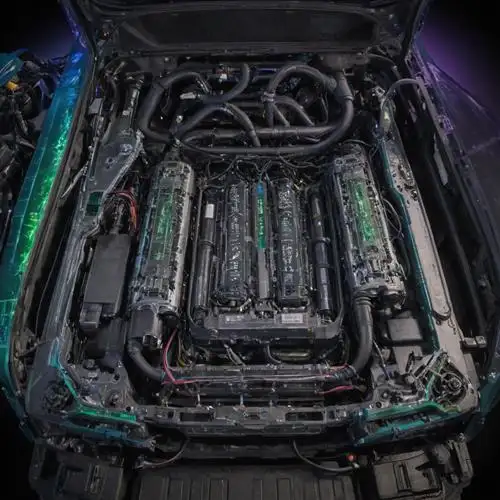
Understanding Your Tesla Model 3's Battery
The battery in your Tesla Model 3 is the heart of the vehicle, and understanding its capabilities and limitations is crucial to maximizing its range. Tesla's battery technology is at the forefront of electric vehicle innovation, and the Model 3's battery is a testament to their engineering prowess.
The Model 3's battery is a lithium-ion battery pack that is designed to provide a balance of energy density, power, and longevity. The battery is composed of individual battery cells that are arranged in a modular design, allowing for easy maintenance and replacement if necessary. The battery pack is actively cooled, using a liquid cooling system to maintain optimal operating temperatures and extend the battery's lifespan.
One of the most critical factors in understanding your Tesla Model 3's battery is its state of charge (SOC). The SOC is a measure of the battery's current charge level, expressed as a percentage of its full capacity. Monitoring your SOC can help you plan your driving and charging routines to ensure you always have enough range to reach your destination.
Another important factor to consider is the battery's energy efficiency. The Model 3's battery is designed to be highly efficient, converting the stored electrical energy into motion with minimal loss. However, various factors can impact the battery's efficiency, including driving style, ambient temperature, and the use of vehicle features such as climate control and infotainment systems.
To maximize the range of your Tesla Model 3, it's important to understand how to optimize the battery's performance. This can include:
- Driving in an energy-efficient manner, such as avoiding rapid acceleration and maintaining a consistent speed
- Minimizing the use of energy-intensive features like climate control and infotainment systems when not necessary
- Charging the battery to an optimal level, typically between 80-90% for daily use to preserve battery health
- Parking in shaded or covered areas to reduce the impact of high ambient temperatures on the battery
- Regularly monitoring the battery's health and degradation over time, and addressing any issues promptly
Driving Techniques for Maximum Range
Maximizing the range of your Tesla Model 3 requires a deliberate and strategic approach to your driving habits. By adopting certain techniques, you can optimize your vehicle's efficiency and squeeze out every last mile from your battery. Let's explore the key considerations that can help you achieve maximum range.
Smooth Acceleration and Deceleration: Gentle acceleration and deceleration are essential for preserving your Model 3's range. Rapid acceleration and harsh braking can significantly drain your battery. Instead, aim for a gradual and steady approach to accelerating and braking. This not only conserves energy but also provides a more comfortable driving experience.
Maintain Consistent Speed: Varying your speed can have a substantial impact on your range. Keep your speed as consistent as possible, avoiding frequent fluctuations. Cruise control can be a valuable tool to maintain a steady pace, particularly on highways. By maintaining a consistent speed, you can minimize the energy required to accelerate and decelerate.
Leverage Regenerative Braking: Your Tesla Model 3 is equipped with regenerative braking, which converts the kinetic energy generated during braking into electrical energy, storing it back in the battery. Maximize the use of regenerative braking by anticipating your stops and gradually easing off the accelerator, allowing the system to capture as much energy as possible.
Reduce Aerodynamic Drag: Aerodynamic efficiency plays a crucial role in range optimization. Minimize the use of roof racks, spoilers, or any other accessories that can increase wind resistance. Additionally, ensure your tires are properly inflated to the recommended pressure, as this can help reduce rolling resistance and improve overall efficiency.
Optimize Climate Control: The climate control system in your Tesla Model 3 can have a significant impact on your range. When possible, use the energy-efficient climate control settings, such as the "Cabin Overheat Protection" feature, which helps maintain a comfortable temperature without draining the battery excessively. Additionally, consider manually adjusting the temperature and fan speed to find the optimal balance between comfort and range.
Regenerative Braking Optimization
Regenerative braking is a revolutionary technology that sets the Tesla Model 3 apart from traditional combustion-engine vehicles. By converting the kinetic energy generated during braking into electrical energy, the Model 3's regenerative braking system can significantly extend the vehicle's driving range. However, to maximize the efficiency of this feature, it's essential to optimize its performance. In this article, we'll explore the intricacies of regenerative braking and provide actionable tips to help you get the most out of your Tesla Model 3.
Understanding Regenerative Braking: Regenerative braking works by using the electric motor as a generator during deceleration. As the vehicle slows down, the electric motor reverses its function, acting as a generator that converts the kinetic energy into electrical energy. This energy is then stored in the vehicle's battery, allowing the battery to recharge while you drive. By harnessing this energy, the Model 3's range is extended, and the burden on the traditional friction brakes is reduced, leading to longer brake pad life.
- Driving Style: Your driving style plays a crucial role in maximizing the effectiveness of regenerative braking. Smooth, gradual braking allows the system to capture more energy, compared to abrupt stops. Anticipate traffic conditions and avoid sudden braking whenever possible, allowing the regenerative braking to work efficiently.
- Regenerative Braking Settings: The Tesla Model 3 offers various settings for regenerative braking, allowing you to customize the experience to your preferences. Experiment with the different settings, such as "Standard" and "Low," to find the one that best suits your driving needs and maximizes range.
- Battery Temperature: The efficiency of regenerative braking is affected by the temperature of the battery. In colder climates, the battery may not be at an optimal temperature, reducing the effectiveness of the regenerative braking system. Consider preheating the battery before driving to ensure maximum efficiency.
- Tire Pressure: Maintaining the correct tire pressure is crucial for optimal energy efficiency, including the performance of the regenerative braking system. Under-inflated tires can increase rolling resistance, reducing the energy that can be recovered during braking.
- Wheel and Tire Selection: The choice of wheels and tires can also impact the effectiveness of regenerative braking. Lighter, more aerodynamic wheels and tires with low rolling resistance can enhance the overall efficiency of the system, allowing you to extract more energy during braking.
- Payload and Cargo: The weight of the vehicle, including any passengers or cargo, affects the amount of kinetic energy that can be recovered during braking. Minimizing the overall weight of the vehicle can help maximize the effectiveness of the regenerative braking system.
Climate Control Strategies for Efficiency
Maximizing the range of your Tesla Model 3 is crucial for getting the most out of your electric vehicle. One key area to focus on is climate control, as it can have a significant impact on your car's energy consumption. Here are some effective strategies to optimize your climate control and improve your Tesla Model 3's efficiency.
Firstly, it's important to understand the impact of temperature on battery performance. Extreme temperatures, whether hot or cold, can reduce the efficiency of your Tesla's battery. In cold weather, the battery may need to work harder to maintain the desired cabin temperature, resulting in a decrease in range. Conversely, in hot weather, the air conditioning system has to work overtime to keep the cabin cool, also leading to a range reduction.
- Utilize the Tesla's "Preconditioning" feature. This allows you to warm or cool the cabin while the car is still plugged in, ensuring the battery is at an optimal temperature before you start your journey. This can significantly improve efficiency by reducing the energy required for climate control once you're on the road.
- Adjust your temperature settings wisely. While it may be tempting to keep the cabin at a chilly 68°F (20°C) in the summer, this will put a significant strain on the air conditioning system. Instead, try setting the temperature a few degrees higher, such as 72°F (22°C). This can help conserve battery power without sacrificing comfort.
- Make use of the Tesla's "Cabin Overheat Protection" feature. This will automatically turn on the air conditioning when the cabin temperature reaches a certain threshold, preventing the car from becoming uncomfortably hot while parked.
- Consider the use of window tinting or sun shades. These can help reduce the amount of heat that enters the cabin, lessening the burden on the air conditioning system.
- Utilize the "Recirculate" mode on the climate control system. This prevents outside air from entering the cabin, which can be more energy-intensive to cool or heat.
- Be mindful of your driving style. Aggressive acceleration and high-speed driving can increase energy consumption, including the energy required for climate control. Adopting a more gentle, efficient driving approach can help maximize your Tesla's range.
Route Planning for Optimal Range
Efficient route planning is crucial for maximizing the range of your Tesla Model 3. The vehicle's energy consumption can vary significantly based on factors such as elevation changes, traffic conditions, and driving style. By carefully considering these elements, you can extend the distance you can travel on a single charge.
When planning your route, prioritize roads with gentle inclines and avoid steep hills whenever possible. Ascending hills requires more energy, reducing your overall range. Conversely, descending hills can provide an opportunity to regenerate energy through the vehicle's braking system, potentially boosting your range.
Traffic congestion is another factor to consider. Frequent stops and starts, as well as idling in heavy traffic, can increase energy consumption. Plan your route to minimize time spent in stop-and-go traffic, opting for highways or arterial roads when feasible.
The driving conditions along your route can also impact your range. Adverse weather, such as strong winds or heavy rain, can increase energy usage as the vehicle works harder to maintain speed and stability. Check weather forecasts and adjust your route accordingly, if necessary.
Your driving style plays a significant role in range optimization. Smooth, gradual acceleration and braking, as well as maintaining a consistent speed, can help maximize your Model 3's efficiency. Avoid rapid acceleration and unnecessary braking, which can quickly deplete your battery's charge.
Additionally, consider the use of energy-saving features, such as the vehicle's Regenerative Braking and Eco Mode. These settings can help optimize energy consumption and extend your range, especially during urban driving or stop-and-go traffic.
















